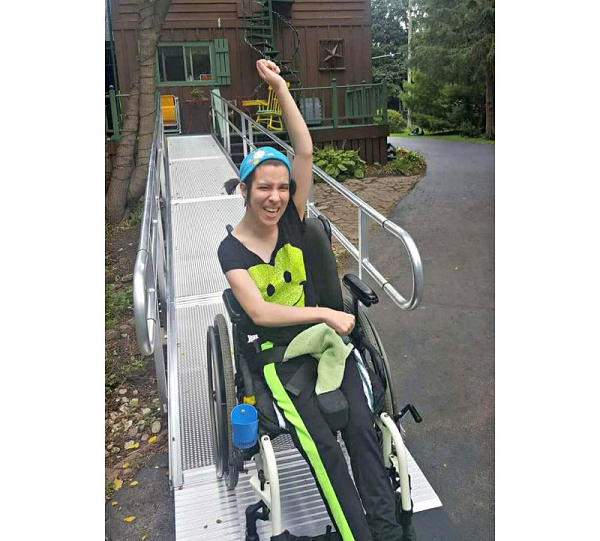




There are many challenges in our homes that can make it difficult for people with limited mobility or disabilities to safely navigate. Fortunately, there are a number of available solutions that enable people to live safely at home. In this post, we'll highlight the solutions that are most often added to make homes safe and fully accessible.
Outdoor Accessible Solutions
Ramps
Wheelchair ramps are one of the most common outdoor accessible solutions for homes. They are cost-effective and usually require little to no maintenance. There are a few options when it comes to the material of wheelchair ramps such as aluminum, concrete and wood. Aluminum style ramps are most often recommended because they allow for easy and quick installation, require the least amount of maintenance, and are very durable.
Porch Lifts
The other common outdoor accessible solution is a porch lift. A porch lift, which is commonly known as a vertical platform lift or wheelchair lift, allows a wheelchair or powerchair user to safely get from the ground level up to the porch or deck at the front or back of a home. These lifts are becoming more common because they are easy to operate for wheelchair and powerchair users, and do not require as much space as wheelchair ramps.
Indoor Accessible Solutions
Getting up and down the stairs inside a home is a common challenge for people who have limited mobility. A stair lift is a very common solution for seniors who may have lost strength in their legs and no longer safely walk up and down the stairs. However, a stair lift is usually not the best solution for wheelchair and powerchair users because it requires that they need to transfer from one chair to another. Some may be able to make the transfer, but many cannot, which makes a wheelchair lift or home elevator a much better solution.
Indoor Wheelchair Lifts
The two types of wheelchair lifts that can be installed inside of a home are vertical platform lifts and inclined platform lifts. A vertical platform lift will most likely require a hoist way, which is why some refer to these types of lifts as elevators. However, the components are much different and so are the lifting systems that enable each to operate. An inclined platform lift is another option that can provide a safe and accessible solution for wheelchair and powerchair users. These types of lifts travel over the stairs on an incline and are sometimes described to as a magic carpet. Inclined platform lifts are not as common as vertical platform lifts because they require more space on a staircase.
Residential Elevators
Residential elevators provide a very convenient way to easily travel between the levels of a home. There are two different types of elevators that can be installed in homes. The first type is a traditional style elevator that operates just a like any elevator that you see in a store or mall. Sliding doors are recommended so that wheelchair users can easily use the elevator by themselves. The other option is a "thru the floor" style residential elevator. While thru the floor elevators are more cost effective and also save room, the cab is often too small to fit a wheelchair or powerchair.
Bathroom Modifications
Bathrooms can be very dangerous and have many obstacles for those who have disabilities. The sink and toilet may be difficult to manage, and getting in and out of the shower or bathtub can be a difficult task. Fortunately, there are many available accessible solutions to solve any of those issues. A roll-under sink can be installed to make a sink easily accessible as it allows for a wheelchair user to be able to roll all the way up to the sink to wash their hands or brush their teeth. Any issues with getting on and off of the toilet may be easily solved by having a linido or toilet incline lift installed. As for showers and bath-tubs, there are a couple of different solutions, but the one that is most recommended is a roll-in shower. A roll-in shower enables wheelchair and powerchair users to be able to roll into the shower in a shower chair. While there are a number of other bathroom safety solutions available, these are the ones that are most recommended for those with disabilities.
Transfer Lifts
There may be situations where person with disabilities cannot safely transfer from a bed to their wheelchair or a shower. A ceiling mounted lift can help caregivers and family members safely lift someone from one place to another within the home.
Source:abilities.com

There are many challenges in our homes that can make it difficult for people with limited mobility or disabilities to safely navigate. Fortunately, there are a number of available solutions that enable people to live safely at home. In this post, we'll highlight the solutions that are most often added to make homes safe and fully accessible.
Outdoor Accessible Solutions
Ramps
Wheelchair ramps are one of the most common outdoor accessible solutions for homes. They are cost-effective and usually require little to no maintenance. There are a few options when it comes to the material of wheelchair ramps such as aluminum, concrete and wood. Aluminum style ramps are most often recommended because they allow for easy and quick installation, require the least amount of maintenance, and are very durable.
Porch Lifts
The other common outdoor accessible solution is a porch lift. A porch lift, which is commonly known as a vertical platform lift or wheelchair lift, allows a wheelchair or powerchair user to safely get from the ground level up to the porch or deck at the front or back of a home. These lifts are becoming more common because they are easy to operate for wheelchair and powerchair users, and do not require as much space as wheelchair ramps.
Indoor Accessible Solutions
Getting up and down the stairs inside a home is a common challenge for people who have limited mobility. A stair lift is a very common solution for seniors who may have lost strength in their legs and no longer safely walk up and down the stairs. However, a stair lift is usually not the best solution for wheelchair and powerchair users because it requires that they need to transfer from one chair to another. Some may be able to make the transfer, but many cannot, which makes a wheelchair lift or home elevator a much better solution.
Indoor Wheelchair Lifts
The two types of wheelchair lifts that can be installed inside of a home are vertical platform lifts and inclined platform lifts. A vertical platform lift will most likely require a hoist way, which is why some refer to these types of lifts as elevators. However, the components are much different and so are the lifting systems that enable each to operate. An inclined platform lift is another option that can provide a safe and accessible solution for wheelchair and powerchair users. These types of lifts travel over the stairs on an incline and are sometimes described to as a magic carpet. Inclined platform lifts are not as common as vertical platform lifts because they require more space on a staircase.
Residential Elevators
Residential elevators provide a very convenient way to easily travel between the levels of a home. There are two different types of elevators that can be installed in homes. The first type is a traditional style elevator that operates just a like any elevator that you see in a store or mall. Sliding doors are recommended so that wheelchair users can easily use the elevator by themselves. The other option is a "thru the floor" style residential elevator. While thru the floor elevators are more cost effective and also save room, the cab is often too small to fit a wheelchair or powerchair.
Bathroom Modifications
Bathrooms can be very dangerous and have many obstacles for those who have disabilities. The sink and toilet may be difficult to manage, and getting in and out of the shower or bathtub can be a difficult task. Fortunately, there are many available accessible solutions to solve any of those issues. A roll-under sink can be installed to make a sink easily accessible as it allows for a wheelchair user to be able to roll all the way up to the sink to wash their hands or brush their teeth. Any issues with getting on and off of the toilet may be easily solved by having a linido or toilet incline lift installed. As for showers and bath-tubs, there are a couple of different solutions, but the one that is most recommended is a roll-in shower. A roll-in shower enables wheelchair and powerchair users to be able to roll into the shower in a shower chair. While there are a number of other bathroom safety solutions available, these are the ones that are most recommended for those with disabilities.
Transfer Lifts
There may be situations where person with disabilities cannot safely transfer from a bed to their wheelchair or a shower. A ceiling mounted lift can help caregivers and family members safely lift someone from one place to another within the home.
Source:abilities.com